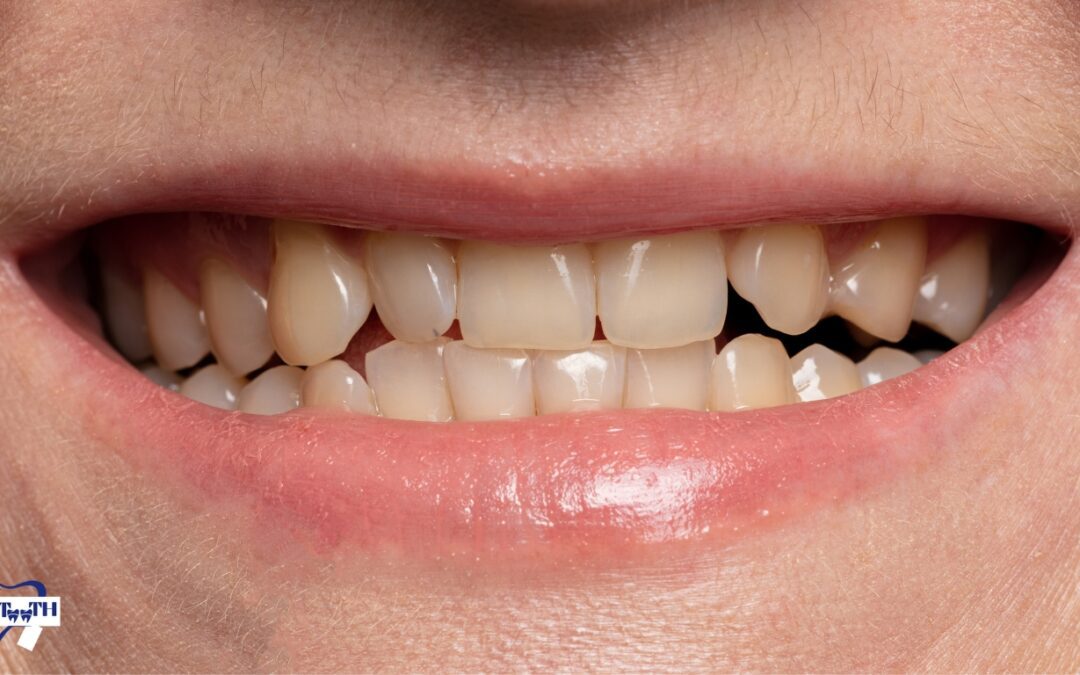Calcification on teeth might be a prevalent dental issue, frequently generating inquiries regarding its origins, manifestations, and available interventions. Mineral deposits accumulate on the enamel’s surface and cause calcification, which can result in apparent alterations and even more severe issues. Maintaining excellent oral health requires understanding the variables contributing to calcification, recognizing its signs, and acquiring appropriate management or prevention techniques.
Table of Contents
In this blog, we explore the complexities of calcification on teeth, offering insightful analysis and helpful tips for managing this dental problem.
What causes calcification on teeth?
Dental calcification, also known as calcification on teeth, results from an accumulation of calcium phosphate salts on the surface of tooth enamel. This procedure may form hard deposits, harming teeth’ appearance and health. Understanding the reasons behind this phenomenon is essential to practice good oral hygiene.
Multiple causes lead to the formation of calcification on teeth. First, inadequate oral hygiene has a significant impact. Insufficient brushing and flossing cause plaque, a sticky bacterial film, to build up on the teeth. This plaque may mineralize over time and become tartar or calculus-hardened deposits. Furthermore, some dietary practices, especially a high intake of acidic or sugary meals and drinks, might worsen plaque development and the ensuing calcification.
Moreover, people who have experienced dental trauma or damage may be more likely to get calcification on their teeth. Trauma can cause structural disruptions in the enamel, facilitating the adhesion and accumulation of calcium phosphate salts. Furthermore, disorders like xerostomia, dry mouth, or decreased salivary flow can impede the process of natural remineralization, making the body more vulnerable to calcification.
Their genetic makeup also influences the likelihood of a person developing calcification on teeth. Regardless of their dental hygiene practices, some persons may have a genetic predisposition to develop more calculus than others.
What are Calcified tooth symptoms?
The accumulation of calcium deposits on the surface of teeth, known as calcification on teeth, can cause several symptoms that are detrimental to oral health. Comprehending these indications is essential for timely identification and remediation. The following are some typical signs of calcified teeth:
Visible White Spots:
The development of white spots on the surface of the enamel is one of the first indications of calcification on teeth. These patches show where mineral deposits have started to build up and change the tooth’s look.
Increased Sensitivity:
As calcification advances, affected teeth may experience increased sensitivity to hot, cold, sweet, or acidic foods and beverages. Changes in the anatomy of the teeth generate this increased sensitivity, which can be uncomfortable when eating or drinking.
Tooth Discolouration:
Severe calcification can cause discernible color shifts in teeth from yellow to brownish. These alterations occur as calcium deposits become more noticeable and modify the enamel’s original hue.
Pain or discomfort:
When calcified teeth reach a more advanced stage, they may feel pain or discomfort, particularly when biting or chewing. The degree of this discomfort can vary, which could signify more severe problems such as dental decay or enamel erosion.

Increased Risk of Decay:
Because of the altered structure of the enamel and the difficulty of cleaning affected regions properly, teeth that have been calcified are more susceptible to decay and cavities. Decaying can spread quickly without preventive care and good dental hygiene and cause further issues.
It is crucial to identify these signs to treat tooth calcification as soon as possible. To control calcification and preserve optimum oral health, dentists can offer individualized treatment regimens involving dental restorations, fluoride treatments, or professional cleanings.
Types of Teeth Calcification
Different forms of teeth calcification on teeth include a spectrum of dental disorders marked by accumulating mineralized materials on the teeth. It’s essential to comprehend these kinds for efficient diagnosis and care.
Dental calculus:
Also referred to as tartar, dental calculus develops when plaque, a bacterial film that sticks to teeth, builds up and becomes more complex due to mineralization. Only expert dental cleaning can remove this hardened deposit, which usually appears as a yellowish or brownish residue along the gumline. Dental calculus can cause gum disease and other oral health problems if not treated.
Pulp stones:
Pulp stones are complex, tiny deposits that occur inside the tooth’s pulp tissue. These calcified entities come in all shapes and sizes, and depending on whether they impinge on a nerve or the dental pulp, they may hurt or show no symptoms. Dental X-rays can identify pulp stones, which may need to be treated depending on their size and location.
Dystrophic calcification:
Trauma or injury to the tooth can lead to dystrophic calcification on teeth. As a result, the pulp or root canal space may develop calcified nodules. Dystrophic calcification can lead to issues, including pulpitis or inflammation of the dental pulp, even though symptoms aren’t usually present. Any underlying problems may need to be addressed to treat dystrophic calcification. In certain situations, root canal therapy may also be necessary.
How to get rid of calcification on teeth?
One common dental problem is calcification on teeth, which results from hard deposits of minerals like phosphate and calcium building up on the surface of teeth. These deposits can cause several issues, such as discoloration, sensitivity, and a higher chance of gum disease and tooth decay. Thankfully, you can take a few actions to assist in removing and avoiding dental calcification.
First and foremost, good oral hygiene is critical. Brushing your teeth with fluoride toothpaste at least twice daily helps eliminate plaque and stop calcification formation. You are cleaning between teeth and along the gum line, where plaque and tartar build-up require frequent flossing.
It is essential to have regular dental checkups and professional cleanings to eliminate persistent calcification that is resistant to removal with simple brushing and flossing. After these appointments, your teeth will be left smooth and clean when your dentist or dental hygienist uses specialized instruments to remove calcification, tartar, and plaque.

Certain over-the-counter medications and products, in addition to expert cleanings, may help lessen dental calcification. For instance, mouthwash or toothpaste containing hydrogen peroxide or baking soda may help dissolve and eliminate calcification over time. You must utilize these items precisely as prescribed and speak with your dentist before beginning new treatment regimens.
Maintaining a nutritious diet reduced in sugar and acidic meals can assist in halting the development of new dental calcification. Saliva serves to neutralize acids and shield dental enamel. Other ways to encourage saliva production include eating sugar-free gum and drinking lots of water.
What is Decalcification teeth?
Tooth decalcification, which frequently happens in tandem with the calcification process, is a common dental problem that can substantially influence oral health. It’s important to talk about decalcification and calcification when discussing dental calcification. This disorder causes weakening and discoloration in portions of the dental enamel due to the loss of minerals, especially calcium and phosphate.
Teeth with decalcification frequently show white patches or spots on the enamel, representing regions where minerals have been lost through leaching. Not only are these patches unattractive, but they also signal the beginning of tooth decay. They frequently result from inadequate oral hygiene habits, like not brushing and flossing enough, which let plaque build-up and create acids that destroy the minerals in the enamel.
Furthermore, teeth decalcification may become more noticeable following orthodontic treatment with braces. Teeth become more prone to decalcification due to the increased difficulties in cleaning teeth with brackets and wires. This emphasizes the importance of taking good care of your teeth while undergoing orthodontic treatment to avoid any issues.
Preventative steps must be taken to address tooth decalcification. First and foremost, good dental hygiene, which includes brushing twice daily with fluoride toothpaste and flossing daily, is imperative. Regular dental examinations also make early detection and treatment possible.
Several therapies, including topical fluoride applications that strengthen teeth and remineralize enamel, can help lessen the effects of decalcification. In more severe situations, dentists could suggest restorative measures like dental sealants to shield the harmed teeth from more harm.
How to fix decalcification on teeth?
For many people, tooth decalcification—frequently indicated by white patches on the enamel—can be a cause for concern. Plaque accumulation is usually the cause of this ailment since it causes the tooth enamel to lose minerals. To address decalcification and restore the health of your teeth, you must practice careful oral hygiene and take some preventive steps.
Promoting better oral hygiene habits is one way to address dental decalcification. Brushing your teeth with fluoride toothpaste at least twice a day can reduce plaque accumulation and strengthen enamel. Furthermore, by reaching between teeth where plaque collects, interdental brushes or dental floss can help stop additional tooth decalcification.
Moreover, adding fluoride treatments to your dental hygiene regimen can help reverse the effects of decalcification. Fluoride reverses the acidic damage produced by plaque by aiding in the remineralization of the enamel. Fluoride varnishes or gels administered directly to the afflicted regions by your dentist may be recommended to strengthen and encourage enamel remineralization.
A balanced diet is essential for treating dental decalcification. Reducing the amount of acidic and sugary meals and drinks consumed can help preserve oral health and stop further enamel degradation. Furthermore, boosting the consumption of foods high in calcium, such as dairy, leafy greens, and almonds, can aid in remineralizing enamel.
What is meant by Decalcification teeth after braces?
One of the most common concerns among people who have received orthodontic treatment is the decalcification of teeth after braces. Braces are used to realign teeth and treat misalignments, but they can also make the area around the brackets and wires more conducive to the growth of plaque and bacteria. Plaque accumulation can cause dental enamel to become decalcified, leaving white patches or spots on the teeth.

It is even more important to maintain good dental hygiene during orthodontic treatment. Brushing and flossing regularly are imperative to remove food debris and plaque from the area around the braces. However, decalcification may occur in some regions due to their difficulty in being cleaned adequately, even with these efforts.
After braces, teeth can become decalcified, leading to aesthetic difficulties. White patches or spots may show, especially after the braces are removed. Decalcification also damages the enamel on teeth, increasing the risk of cavities and tooth decay.
Proactive steps must be taken both during and after orthodontic treatment to prevent decalcification of the teeth following braces. Dentists may advise strengthening enamel and remineralizing teeth using mouthwash or fluoride toothpaste. Frequent dental examinations are also necessary to track the health of the teeth and quickly address any issues.
Conclusion
Maintaining the best possible dental health requires understanding teeth’ calcification. Those aware of the causes, symptoms, and available treatments can effectively manage calcification problems. Calcification on teeth can be prevented and managed with regular dental checkups and good oral hygiene. If the calcification is severe or persistent, it’s also advised to consult a dentist for guidance. By being proactive and knowledgeable, people can work to protect the integrity of their teeth and have a bright, healthy smile for many years.
FAQs
Q: Is it possible to stop teeth from calcification on teeth?
A: Proper dental hygiene, which includes brushing and flossing twice a day with fluoride toothpaste and scheduling frequent cleanings and checkups at the dentist, will help avoid tooth calcification. Calcification on teeth can also be prevented by eating a balanced diet and limiting fluoride exposure.
Q: How can the calcification on teeth be removed?
A: In most cases, expert dental treatment is necessary to remove calcification from teeth. Your dentist might prescribe scaling and polishing to remove the deposits. Additionally, you can stop additional calcification by practicing good oral hygiene and listening to your dentist’s advice.
Q: Are there any DIY treatments available for tooth calcification?
A: Even though teeth calcification on teeth frequently requires professional dental care, several at-home treatments can promote oral health. These include minimizing sugary and acidic foods and beverages, using fluoride mouthwash, and eating foods high in calcium and vitamin D.
Q: Can teeth get decalcified as a result of braces?
A: Having braces can make decalcification more likely, especially if good oral hygiene is neglected. Cavities or white patches may arise from demineralization of the enamel caused by plaque accumulation around braces. To avoid decalcification, brush and floss your teeth thoroughly when receiving orthodontic treatment.
Q: Is it possible to undo calcification on teeth?
A: With proper dental care and treatments, tooth calcification may be reversed in its early stages. However, more involved dental operations can be necessary to treat advanced cases.

